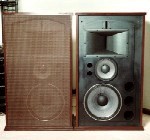
Originally Posted by
speakerdave
This is the big shortcoming in Drew Daniels's system--no response tailoring information whatever. The early versions prescribe a pair of UREI 525 crossovers, but the later system uses some BGW amps with custom contour cards for the various drivers. Go figure. And he does not share the contour information with the reader. I looked at this myself before deciding that it was nothing but a small scale PA, probably a pretty good one, but I doubt it would be at all satisfactory for in-home use, as Widget says. Remember, his target audience is the dedicated crowd that has been listening to D130's with N2400's and 075's since 1957 and now have the leisure to spend some of their children's inheritance on a balls-out system. Drew's to be commended for recommending the LSR32. In fact he was fairly adamant about it; if I find the reference I will post it, but I confirm Widget--it's out there. If you want to make a home-brew large format JBL, study the studio monitor series, including the K2's, and pick one you can get the parts for and copy crossover information. Anything else is fraught with difficulties.
David






 Reply With Quote
Reply With Quote





